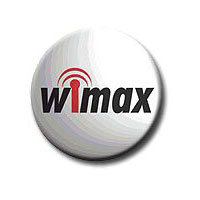
 Wi-MAX
Wi-MAXWiMAX, meaning Worldwide Interoperability for Microwave Access, is a telecommunications technology that provides wireless transmission of data using a variety of transmission modes, from point-to-multipoint links to portable and fully mobile internet access. The technology provides up to 10 Mbps broadband speed without the need for cables. The technology is based on the IEEE 802.16 standard (also called Broadband Wireless Access). The name "WiMAX" was created by the WiMAX Forum, which was formed in June 2001 to promote conformity and interoperability of the standard. The forum describes WiMAX as "a standards-based technology enabling the delivery of last mile wireless broadband access as an alternative to cable and DSL".
Main UsesThe bandwidth and range of WiMAX make it suitable for the following potential applications:
* Connecting Wi-Fi hotspots to the Internet.
* Providing a wireless alternative to cable and DSL for "last mile" broadband access.
* Providing data, telecommunications and IPTV services (triple play).
* Providing a source of Internet connectivity as part of a business continuity plan. That is, if a business has both a fixed and a wireless Internet connection, especially from unrelated providers, they are unlikely to be affected by the same service outage.
* Providing portable connectivity.
Wi-Max Broadband accessCompanies are evaluating WiMAX for last mile connectivity. The resulting competition may bring lower pricing for both home and business customers or bring broadband access to places where it has been economically unavailable.

WiMAX access was used to assist with communications in Aceh, Indonesia, after the tsunami in December 2004. All communication infrastructure in the area, other than amateur radio, was destroyed, making the survivors unable to communicate with people outside the disaster area and vice versa. WiMAX provided broadband access that helped regenerate communication to and from Aceh.
In addition, WiMAX was donated by Intel Corporation to assist the FCC and FEMA in their communications efforts in the areas affected by Hurricane Katrina.[5] In practice, volunteers used mainly self-healing mesh, VoIP, and a satellite uplink combined with Wi-Fi on the local link
IPTV over WiMAXDeploying Internet access and Voice over IP using WiMAX radio access is quite easy. In order to have a full triple-play offer, IPTV service has to be added. But it's not straight forward, since the use of IP multicast over a WiMAX radio transmission to carry the IPTV channels may be a technical challenge. Such commercial service are not yet available, but trials have been conducted or are undeway.
Comparison with Wi-FiComparisons and confusion between WiMAX and Wi-Fi are frequent because both are related to wireless connectivity and Internet access.
* WiMAX is a long range system, covering many kilometers, that uses licensed or unlicensed spectrum to deliver a point-to-point connection to the Internet.
* Different 802.16 standards provide different types of access, from portable (similar to a cordless phone) to fixed (an alternative to wired access, where the end user's wireless termination point is fixed in location.)
* Wi-Fi uses unlicensed spectrum to provide access to a network.

* Wi-Fi is more popular in end user devices.
* WiMAX and Wi-Fi have quite different quality of service (QoS) mechanisms:
o WiMAX uses a QoS mechanism based on connections between the base station and the user device. Each connection is based on specific scheduling algorithms.
o Wi-Fi has a QoS mechanism similar to fixed Ethernet, where packets can receive different priorities based on their tags. For example VoIP traffic may be given priority over web browsing.
* Wi-Fi runs on the Media Access Control's CSMA/CA protocol, which is connectionless and contention based, whereas WiMAX runs a connection-oriented MAC.
* Both 802.11 and 802.16 define Peer-to-Peer (P2P) and ad hoc networks, where an end user communicates to users or servers on another Local Area Network (LAN) using its access point or base station.
BSNL Launched country's first mobile broadband fourth generation Internet access network--Mobile
WiMAX in
Kerala.Union minister of state for Agriculture and Consumer Affairs K V Thomas, launched the facility at Kochi
BSNL is also the first operator in the country to launch the service, for which technology has been provided by AVIAT, formerly Harris Stratex.
WiMAX (Worldwide Interoperability for Microwave Access) technology, can provide a speed of up to 37 mbps. It is being deployed in Kerala with 900 BTS (Base Transmitting Stations) to cover the entire state, Principal General Manager,
BSNL, Ernakulam, E M Abraham said.
In the first phase, 450 BTS would be set up to cover all major cities, district headquarters and important towns at a project cost of about Rs 100 crore.
In the second phase, another 450 BTS would be commissioned to cover the remaining towns.
The technology will provide access to broadband at a cost performance ratio that is far better than any other technology, he said.
It provides features like high speed broad band connectivity anywhere, anytime for devices like Desktop, Laptop on wireless.
It has two tariff plans - Home Plan with a fixed monthly charge of Rs 999 while the Business plan is Rs 1,999 for a band width 512 to 2 mbps.

WiMax (World Interoperability for Microwave Access) has been provided by AVIAT, formerly Harris Stratex. 450 BTS are being set up to cover major cities, district headquarters and important towns. 25 BTS will cover Ernakulam, Tripunithura, Kalamassery, Aluva and Angamally muncipalities.
Alluva and Angamally was commissioned on the same day and the remaining 59 are to be commissioned soon. It has two tariff plans – Home Plan with a fixed monthly charge of Rs 999 while the Business plan is Rs 1,999 for a band width 512 to 2 mbps. It provides features like high speed broad band connectivity anywhere, anytime for devices like Desktop, Laptop on wireless.
 Wi-Fi
Wi-Fi















